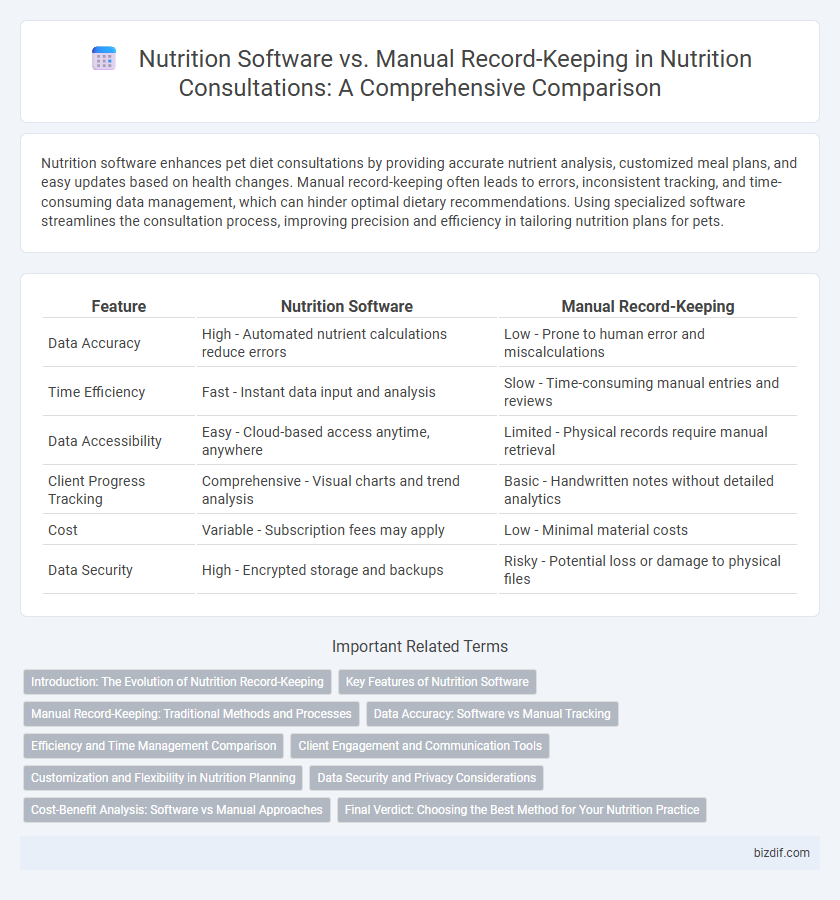Nutrition software enhances pet diet consultations by providing accurate nutrient analysis, customized meal plans, and easy updates based on health changes. Manual record-keeping often leads to errors, inconsistent tracking, and time-consuming data management, which can hinder optimal dietary recommendations. Using specialized software streamlines the consultation process, improving precision and efficiency in tailoring nutrition plans for pets.
Table of Comparison
| Feature | Nutrition Software | Manual Record-Keeping |
|---|---|---|
| Data Accuracy | High - Automated nutrient calculations reduce errors | Low - Prone to human error and miscalculations |
| Time Efficiency | Fast - Instant data input and analysis | Slow - Time-consuming manual entries and reviews |
| Data Accessibility | Easy - Cloud-based access anytime, anywhere | Limited - Physical records require manual retrieval |
| Client Progress Tracking | Comprehensive - Visual charts and trend analysis | Basic - Handwritten notes without detailed analytics |
| Cost | Variable - Subscription fees may apply | Low - Minimal material costs |
| Data Security | High - Encrypted storage and backups | Risky - Potential loss or damage to physical files |
Introduction: The Evolution of Nutrition Record-Keeping
Nutrition record-keeping has evolved from traditional manual methods to advanced nutrition software, transforming data accuracy and client management. Modern nutrition software offers real-time analysis, personalized meal planning, and seamless integration with health tracking devices, significantly enhancing practitioner efficiency. Manual record-keeping often results in errors and time-consuming processes, whereas digital solutions streamline workflows and improve client outcomes.
Key Features of Nutrition Software
Nutrition software streamlines client data management by automating meal planning, nutrient analysis, and progress tracking, ensuring accurate and personalized dietary recommendations. Integrated databases provide real-time updates on food composition, facilitating evidence-based adjustments to nutrition plans. Unlike manual record-keeping, this technology enhances efficiency, reduces errors, and supports comprehensive reports for improved patient outcomes.
Manual Record-Keeping: Traditional Methods and Processes
Manual record-keeping in nutrition consultation involves handwritten logs, physical charts, and paper-based food diaries to track clients' dietary intake and progress. These traditional methods rely heavily on meticulous documentation and can be time-consuming, increasing the risk of errors and data loss. Despite limitations, manual processes offer personalized client interaction and immediate adaptability without requiring digital tools or software expertise.
Data Accuracy: Software vs Manual Tracking
Nutrition software significantly improves data accuracy by automating calculations and reducing human errors common in manual record-keeping. Digital platforms enable precise tracking of nutrient intake, portion sizes, and client progress through integrated food databases and real-time updates. Manual tracking often leads to inconsistencies and inaccuracies due to reliance on memory and manual entry, compromising the quality of nutrition assessments and recommendations.
Efficiency and Time Management Comparison
Nutrition software streamlines data entry and analysis, significantly reducing the time spent on manual calculations and record updates. Automated nutrient tracking and client progress reports enhance efficiency, enabling nutritionists to manage more clients effectively. Manual record-keeping is prone to errors and requires lengthy sessions for data review, hindering time management and overall productivity.
Client Engagement and Communication Tools
Nutrition software enhances client engagement by providing interactive dashboards, real-time progress tracking, and personalized meal planning, which manual record-keeping lacks. Built-in communication tools such as secure messaging and video conferencing streamline interactions, improving responsiveness and client satisfaction. These digital features foster stronger client-practitioner relationships and facilitate more accurate, efficient nutritional guidance.
Customization and Flexibility in Nutrition Planning
Nutrition software offers extensive customization options, allowing practitioners to tailor meal plans based on specific dietary needs, allergies, and client preferences with precision. Manual record-keeping often lacks flexibility, making it challenging to quickly adjust nutrition plans or integrate new data efficiently. Advanced nutrition tools streamline updates and adapt plans dynamically, enhancing personalized client care and improving adherence to nutritional goals.
Data Security and Privacy Considerations
Nutrition software offers robust data encryption and access controls that significantly enhance the security and privacy of client information compared to manual record-keeping. Manual methods are more vulnerable to physical loss, unauthorized access, and human error, increasing the risk of data breaches in nutrition consultations. Implementing secure nutrition software aligns with compliance standards like HIPAA, ensuring better protection of sensitive dietary and health data.
Cost-Benefit Analysis: Software vs Manual Approaches
Nutrition software streamlines data entry, reduces human errors, and enables real-time dietary analysis, offering long-term cost savings despite initial investment fees. Manual record-keeping incurs lower upfront expenses but demands increased staff time, risks inaccurate data, and limits scalability, which can lead to higher operational costs over time. Evaluating return on investment (ROI) shows that nutrition software enhances efficiency and client outcomes, proving more cost-effective for growing nutrition practices compared to traditional manual methods.
Final Verdict: Choosing the Best Method for Your Nutrition Practice
Nutrition software streamlines client data management, enhances analysis accuracy, and provides personalized meal planning tools essential for modern dietitians. Manual record-keeping, while cost-effective and straightforward, often leads to inefficiencies and increased risk of errors in tracking dietary progress. Selecting the best method depends on practice size, budget, and the need for scalability and integration with digital health platforms.
Nutrition Software vs Manual Record-keeping Infographic

 bizdif.com
bizdif.com